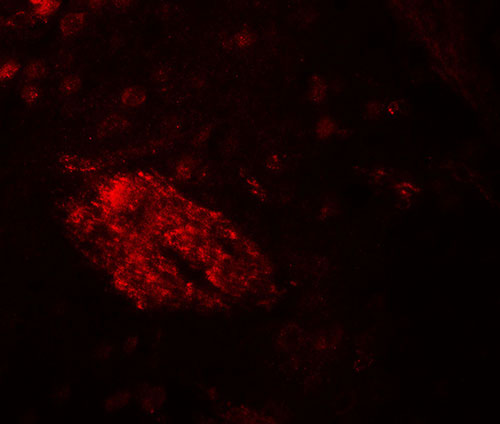WDR61 Antibody
- 产品详情
- 实验流程
- 背景知识
Application
| WB, IF, E, IHC-P |
|---|---|
| Primary Accession | Q9GZS3 |
| Other Accession | NP_079510, 13376840 |
| Reactivity | Human, Mouse, Rat |
| Host | Rabbit |
| Clonality | Polyclonal |
| Isotype | IgG |
| Calculated MW | 33581 Da |
| Concentration (mg/ml) | 1 mg/mL |
| Conjugate | Unconjugated |
| Application Notes | WDR61 antibody can be used for detection of WDR61 by Western blot at 1 - 2 µg/ml. Antibody can also be used for immunohistochemistry starting at 5 µg/mL. For immunofluorescence start at 20 µg/mL. |
| Gene ID | 80349 |
|---|---|
| Other Names | WD repeat-containing protein 61, Meiotic recombination REC14 protein homolog, SKI8 homolog, Ski8, WD repeat-containing protein 61, N-terminally processed, WDR61 |
| Target/Specificity | WDR61; WDR61 antibody is human, mouse and rat reactive. |
| Reconstitution & Storage | WDR61 antibody can be stored at 4℃ for three months and -20℃, stable for up to one year. |
| Precautions | WDR61 Antibody is for research use only and not for use in diagnostic or therapeutic procedures. |
| Name | SKIC8 (HGNC:30300) |
|---|---|
| Synonyms | WDR61 |
| Function | Component of the PAF1 complex (PAF1C) which has multiple functions during transcription by RNA polymerase II and is implicated in regulation of development and maintenance of embryonic stem cell pluripotency (PubMed:16307923, PubMed:19952111, PubMed:20178742). PAF1C associates with RNA polymerase II through interaction with POLR2A CTD non-phosphorylated and 'Ser-2'- and 'Ser-5'-phosphorylated forms and is involved in transcriptional elongation, acting both independently and synergistically with TCEA1 and in cooperation with the DSIF complex and HTATSF1 (PubMed:16307923, PubMed:19952111, PubMed:20178742). PAF1C is required for transcription of Hox and Wnt target genes (PubMed:16307923, PubMed:19952111, PubMed:20178742). PAF1C is involved in hematopoiesis and stimulates transcriptional activity of KMT2A/MLL1; it promotes leukemogenesis through association with KMT2A/MLL1- rearranged oncoproteins, such as KMT2A/MLL1-MLLT3/AF9 and KMT2A/MLL1- MLLT1/ENL (PubMed:16307923, PubMed:19952111, PubMed:20178742). PAF1C is involved in histone modifications such as ubiquitination of histone H2B and methylation on histone H3 'Lys-4' (H3K4me3) (PubMed:16307923, PubMed:19952111, PubMed:20178742). PAF1C recruits the RNF20/40 E3 ubiquitin-protein ligase complex and the E2 enzyme UBE2A or UBE2B to chromatin which mediate monoubiquitination of 'Lys-120' of histone H2B (H2BK120ub1); UB2A/B-mediated H2B ubiquitination is proposed to be coupled to transcription (PubMed:16307923, PubMed:19952111, PubMed:20178742). PAF1C is involved in mRNA 3' end formation probably through association with cleavage and poly(A) factors (PubMed:16307923, PubMed:19952111, PubMed:20178742). In case of infection by influenza A strain H3N2, PAF1C associates with viral NS1 protein, thereby regulating gene transcription (PubMed:16307923, PubMed:19952111, PubMed:20178742). Required for mono- and trimethylation on histone H3 'Lys-4' (H3K4me3), dimethylation on histone H3 'Lys-79' (H3K4me3). Required for Hox gene transcription (PubMed:16307923, PubMed:19952111, PubMed:20178742). Also acts as a component of the SKI complex, a multiprotein complex that assists the RNA-degrading exosome during the mRNA decay and quality-control pathways (PubMed:16024656, PubMed:32006463, PubMed:35120588). The SKI complex catalyzes mRNA extraction from 80S ribosomal complexes in the 3'-5' direction and channels mRNA to the cytosolic exosome for degradation (PubMed:32006463, PubMed:35120588). SKI-mediated extraction of mRNA from stalled ribosomes allow binding of the Pelota-HBS1L complex and subsequent ribosome disassembly by ABCE1 for ribosome recycling (PubMed:32006463). |
| Cellular Location | Nucleus. Cytoplasm |
For Research Use Only. Not For Use In Diagnostic Procedures.
Provided below are standard protocols that you may find useful for product applications.
BACKGROUND
WDR61 (WD-repeat-containing protein 61), also known as SKI8 or REC14, is a subunit of the human PAF and SKI complexes, which function in transcriptional regulation and are involved in events downstream of RNA synthesis, such as RNA surveillance (1,2). PAF1C is implicated in regulation of development and maintenance of embryonic stem cell pluripotency. Component of the SKI complex which is thought to be involved in exosome-mediated RNA decay and associates with transcriptionally active genes in a manner dependent on PAF1C (3,4).
REFERENCES
Zhu B, Mandal SS, Pham AD, et al. The human PAF complex coordinates transcription with events downstream of RNA synthesis. Genes Dev. 2005; 19:1668-73.
Zhu B, Zheng Y, Pham AD, et al. Monoubiquitination of human histone H2B: the factors involved and their roles in HOX gene regulation. Mol. Cell. 2005; 20:601-11.
Kim J, Guermah M, and Roeder RG. The human PAF1 complex acts in chromatin transcription elongation both independently and cooperatively with SII/TFIIS. Cell 2010; 140:491-503.
Chen Y, Yamaguchi Y, Tsugeno Y, et al. DSIF, the Paf1 complex, and Tat-SF1 have nonredundant, cooperative roles in RNA polymerase II elongation. Genes Dev. 2009; 23):2765-77.
终于等到您。ABCEPTA(百远生物)抗体产品。
点击下方“我要评价 ”按钮提交您的反馈信息,您的反馈和评价是我们最宝贵的财富之一,
我们将在1-3个工作日内处理您的反馈信息。
如有疑问,联系:0512-88856768 tech-china@abcepta.com.























 癌症的基本特征包括细胞增殖、血管生成、迁移、凋亡逃避机制和细胞永生等。找到癌症发生过程中这些通路的关键标记物和对应的抗体用于检测至关重要。
癌症的基本特征包括细胞增殖、血管生成、迁移、凋亡逃避机制和细胞永生等。找到癌症发生过程中这些通路的关键标记物和对应的抗体用于检测至关重要。 为您推荐一个泛素化位点预测神器——泛素化分析工具,可以为您的蛋白的泛素化位点作出预测和评分。
为您推荐一个泛素化位点预测神器——泛素化分析工具,可以为您的蛋白的泛素化位点作出预测和评分。 细胞自噬受体图形绘图工具为你的蛋白的细胞受体结合位点作出预测和评分,识别结合到自噬通路中的蛋白是非常重要的,便于让我们理解自噬在正常生理、病理过程中的作用,如发育、细胞分化、神经退化性疾病、压力条件下、感染和癌症。
细胞自噬受体图形绘图工具为你的蛋白的细胞受体结合位点作出预测和评分,识别结合到自噬通路中的蛋白是非常重要的,便于让我们理解自噬在正常生理、病理过程中的作用,如发育、细胞分化、神经退化性疾病、压力条件下、感染和癌症。








